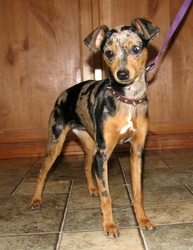

OUR GENTLEMEN (Duncan and Finlay)
|
Here is a little information about my involvement with the harlequin or merle miniature pinscher. In the spring of 1998, when I was researching miniature pinschers to see if they were the dog for me, I kept running across mention of the harlequin miniature pinscher. As I enjoy researching and learning, I kept going until I found a description of the harlequin color. Sounded like either merle or piebald to me, depending on the description. After we got internet service, I continued my research until I finally found photos of the harlequin colored miniature pinschers. The photos showed a merle colored dog, and some old postcards of minpins showed various other markings and patterns. Among those was a dark dog with lots of white markings (piebald?). I read that the color harlequin was in the old breed standards, and was banned from the showring by first making it a fault, and then later a disqualification. Well this seemed so wrong to me. I had been around merle colored dogs in the past, and some of them were absolutely beautiful. I really thought a mistake had been made when I read that the reason the merle color was banned from the showring was that the dogs didn't "look refined". "Look refined?" What did that mean? I suppose that means that Collies, and shelties, and catahoulas, and great danes, and dachshunds, and etc. that come in the color merle also don't "look refined"? Not likely. Definitely to my way of thinking a mistake had been made. I continued researching until I made contact with Nancy Anderson. She was in touch with some breeders that were making an attempt to revive the merle color pattern by using a one time cross with a merle type A rat terrier. Now, I had had that thought myself, but these breeders were some steps ahead of me. So, I stayed in contact with Nancy until it happened that she had a merle litter born. They were F8 puppies. 8 generations of nothing but minpin except for one merle rat terrier. Eureka! Those were beautiful pups, and one of them was mine! Well, as sometimes happens, a series of unfortunate events claimed the life of my baby puppy. I was given the option to get a refund, or wait for another merle puppy. I chose to wait as by now this dream of a harlequin minpin was about 8 or 9 years old. And I am so glad that I did. Now I have my merle (harlequin) minpin girl. It is no secret that rat terrier blood was infused to revive the merle color. IF genetics were as reliable as mathematics I could say that this pup was about 99.6% pure minpin. Well, genes don't work exactly that way, but she is pure enough minpin for a lot of registries to register her as miniature pinscher. And she sure looks like a miniature pinscher. Since she is a red merle, the color doesn't show as well as some of the other colors in the merle, but she should pass the pattern on to some of her offspring. With her color background in her pedigree, and the color background in some of my dogs, I should end up with some interesting colors and patterns in the future. These dogs will not be registerable with AKC, but will be registered with ACR. They will have their 5 or more gen. pedigree, thanks to a lot of work by Sharon MacDonald, who was also inspired with the help of Nancy Anderson to begin this adventure. Seren is dual registered as miniature pinscher and harlequin pinscher. I do welcome input from other interested people, but if you contact me just to condemn what I am doing, please don't waste my time or yours. I made the decision to do my best to help revive an historic color pattern in the breed a long time ago. A color pattern that a tiny minority ruled to eliminate. No vote was made of miniature pinscher breeders. Their opinion was not considered. I truly believe that taking the action that was taken was a disservice to the breed, and to the people that LIKE the color merle. And wait until you see or meet some merle/harlequin minpins before making a rush to judgment. A rush to judgment is what eliminated the color from the breed to start with. Photos below. |
||
|
This is an example of a black and tan merle puppy at about 3 weeks of age.
|
||
| Red merle puppy The puppy facing the camera in this photo is a little red merle female at 14 weeks of age. The pattern on this puppy is difficult to see in this photo. | ||
| Pattern
This is a photo of Buttons. She is black and rust merle. As you can see by the spot in her eye, one eye is partially blue. This is common in merle dogs, as the eye color is affected by the merling. An interesting thing about Buttons is that while the rust marking on her right front leg is merled, the marking on her left front shows no merling. Part of the fun is not knowing what pattern will appear in the harlequins.
|
||



